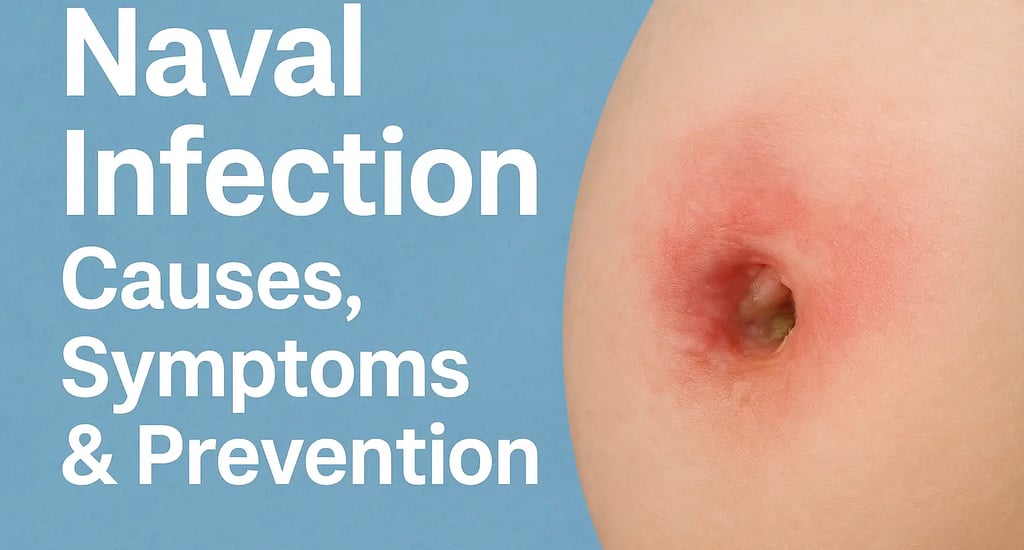Naval Infection (Umbilical Infection): Causes, Symptoms, Treatment & Prevention
Learn everything about naval infection (umbilical infection), including causes, symptoms, treatment options, and prevention tips. Keep your navel healthy with proper hygiene and care.


What is a Naval Infection?
A naval infection, also known as umbilical infection or omphalitis, is an inflammation or infection that develops in the navel (belly button). This condition can affect people of all ages but is particularly common in newborns due to the fresh scar left after the umbilical cord is cut.
Since the navel is a natural skin fold, it can easily trap moisture, dirt, and bacteria, making it vulnerable to infections. Poor hygiene, excessive sweating, or even foreign objects like surgical threads can contribute to the risk. In people with weak immune systems or conditions like diabetes, the chances of developing a navel infection increase significantly.
Common Symptoms of a Naval Infection
Recognizing the symptoms early is crucial for timely treatment. Signs of a navel infection may include:
Redness and swelling around the belly button
Pain or tenderness in the navel area
Discharge (clear, yellow, or pus-like)
Foul odor from the belly button
Itching or irritation
Fever and general weakness (in severe cases)
If these symptoms persist or worsen, medical attention should be sought immediately.
Causes and Risk Factors of Naval Infection
A naval infection usually develops when bacteria or fungi invade the belly button.
Main Causes:
Bacterial infections – Commonly caused by Staphylococcus or Streptococcus
Fungal infections – Often due to Candida yeast growth in moist environments
Poor hygiene – Irregular cleaning can allow dirt, sweat, and oils to accumulate
Moisture & sweating – Creates an ideal environment for bacteria and fungi
Skin irritations – Cuts, rashes, or tight clothing can allow germs to enter
High-Risk Groups:
Individuals with diabetes or weak immunity
People who sweat excessively or swim in contaminated water
Those with navel piercings without proper aftercare
Newborns with recently cut umbilical cords
Diagnosis and Treatment
Diagnosis
A healthcare provider usually diagnoses a naval infection through a physical exam, checking for swelling, redness, and discharge. In some cases, a swab test may be done to identify the specific bacteria or fungi.
Treatment Options
Mild infections:
Gently wash with warm water and mild soap
Keep the area dry and clean
Apply antiseptic solutions
Use over-the-counter (OTC) antibiotic or antifungal creams
Severe infections:
Prescription antibiotics (oral or topical)
Drainage of abscesses if pus has formed
Medical treatment for underlying conditions like diabetes
Prompt treatment prevents the infection from spreading to surrounding tissues.
Prevention Tips and Best Practices
Preventing a naval infection is simple with proper care:
Maintain hygiene – Clean your navel daily with mild soap and warm water.
Keep it dry – Moisture promotes bacterial growth, so always dry your navel after bathing.
Wear breathable fabrics – Opt for cotton clothing to reduce sweat buildup.
Avoid tight clothing – Prevents friction and irritation.
Piercing care – Clean piercings with saline solution and avoid touching with unwashed hands.
Healthy lifestyle – Good nutrition, hydration, and regular exercise strengthen immunity.
Final Thoughts
A naval infection can range from mild discomfort to serious health risks if left untreated. With proper hygiene, early detection, and the right treatment, most infections heal quickly. If symptoms persist or worsen, always consult a healthcare provider to prevent complications.
